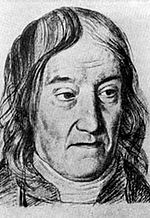In geometry, the Wallace–Bolyai–Gerwien theorem, named after William Wallace, Farkas Bolyai and P. Gerwien, is a theorem related to dissections of polygons...
8 KB (990 words) - 06:47, 5 July 2024
Farkas Bolyai (Hungarian: [ˈfɒrkɒʃ ˈboːjɒi]; 9 February 1775 – 20 November 1856; also known as Wolfgang Bolyai in Germany) was a Hungarian mathematician...
6 KB (610 words) - 16:59, 14 June 2024
dimensions is "yes" and had been known for a long time; this is the Wallace–Bolyai–Gerwien theorem. Unknown to Hilbert and Dehn, Hilbert's third problem was also...
11 KB (1,471 words) - 08:54, 10 October 2024
Waldhausen's theorem (geometric topology) Wallace–Bolyai–Gerwien theorem (discrete geometry) Walter theorem (finite groups) Weber's theorem (algebraic curves)...
73 KB (6,030 words) - 15:22, 20 October 2024
William Wallace proves that any two simple polygons of equal area are equidecomposable, later known as the Wallace–Bolyai–Gerwien theorem. Samuel Hahnemann...
6 KB (559 words) - 16:56, 16 June 2024
axis-parallel cuts and translations. In two dimensions, the Wallace–Bolyai–Gerwien theorem from the early 19th century states that any two polygons of...
40 KB (5,770 words) - 21:54, 21 August 2024
triangle (pictured) in his 1907 book The Canterbury Puzzles. The Wallace–Bolyai–Gerwien theorem, first proven in 1807, states that any two equal-area polygons...
6 KB (547 words) - 18:57, 20 May 2024
about polygons with an equal area, that later became known as the Bolyai–Gerwien theorem. His most important contribution to British mathematics however...
7 KB (769 words) - 22:25, 10 June 2024
Forsyth. William Wallace proves that any two simple polygons of equal area are equidecomposable, later known as the Bolyai–Gerwien theorem. 27 March – Lauderdale...
6 KB (573 words) - 09:48, 30 May 2024





